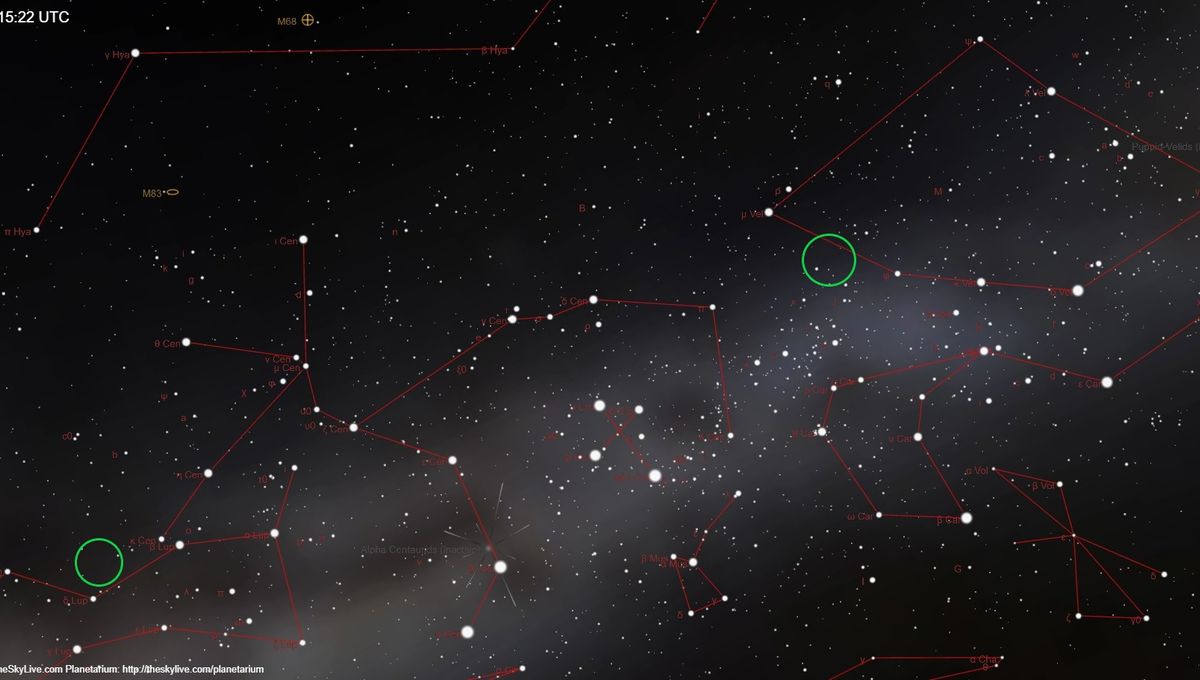
A second nova has joined V462 Lupi in the sky, providing a brief window where both are visible at once without binoculars or telescopes under the right conditions. Such an event has only been recorded once before, and happened so quickly that no one noticed at the time.
Astronomers spent much of 2024 anxiously awaiting the brightening of T Coronae Borealis, a recurring nova thought to flare roughly every 80 years. It has yet to show, probably because the original prediction was a lot more tentative about the timeline than much of the subsequent reporting.
However, most novae are not recurring; instead, they flare up unpredictably. To compensate for T Coronae Borealis’s no-show (or at least tardiness), V462 Lupi was spotted on June 12, peaking in brightness on June 21. Although V462 Lupi is now on its way down, it is still visible to the naked eye under the right conditions and has now been joined by a second nova, V572 Velorum, which briefly became somewhat brighter.
V572 Velorum appears to have peaked on June 27, at a magnitude of 4.8, and has now faded to around 5.8. Although V562 Lupi never got as bright, it has faded much more slowly, and hovered around a magnitude of 5.9 throughout this period.
Although the name means “new star,” a nova is neither new nor technically a single star. Neither of these things was known when the name was created, as stars appeared where none had been seen before. Now we know that novae are created by a dance between a white dwarf and a main-sequence star, where the outer layers of the ordinary star are pulled away and eventually settle on the companion.
The remaining is heated to temperatures of around 20 million degrees, initiating fusion and causing a flare that lasts weeks. Most novae are too distant to be seen with the naked eye, and so were seldom spotted until telescopes became widespread. Since they look like ordinary stars at a distance of many light-years, you need to know the sky extremely well to recognize an interloper unless it is exceptionally bright.
With naked-eye novae only happening once every few years, and visible for short periods of time, the chance of there being two at once is naturally low. “This is without question an extremely rare event, if not a historical one,” astronomer and photographer Stephen O’Meara told Spaceweather.com. At the time, O’Meara had not found another example, with the closest being in 1936 when two novae almost overlapped.
However, O’Meara subsequently told Earthsky he’d found a brief period in 2018 when two novae, which both barely reached naked-eye visibility, peaked on the same day.
Both V462Lupi and V572 Velorum are deep in the southern sky (40° and 53° S, respectively). That means they are impossible to see from much of the Northern Hemisphere, and difficult even at mid-latitudes.
For those far enough south to see the pair, you will either need to get under very dark skies or use binoculars. Magnitudes below 6.0 are considered to be visible to the naked eye, but it requires quite good eyesight to get to that even without interference. At least both are high in the evening southern sky at the moment, on opposite sides of the Southern Cross.
As well as fading, the two stars will change color with time, shifting from blue to red as they cool.
Source Link: For Only The Second Recorded Time, Two Novae Are Visible With The Naked Eye At Once